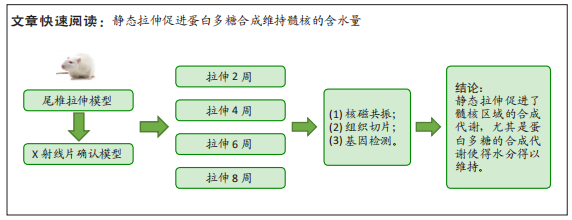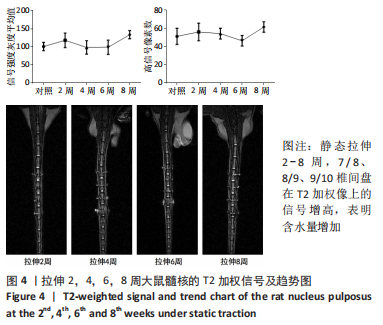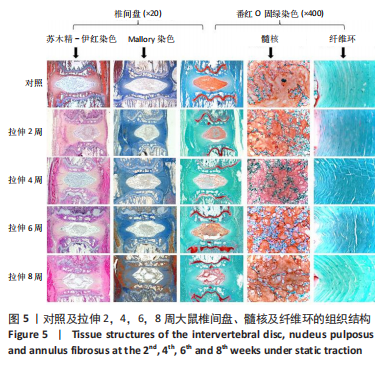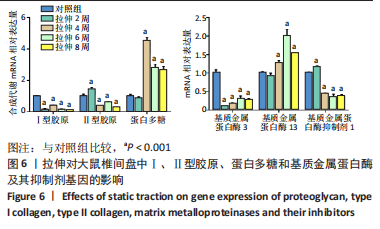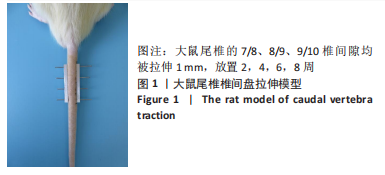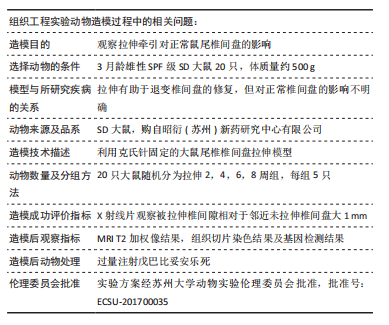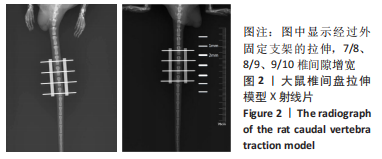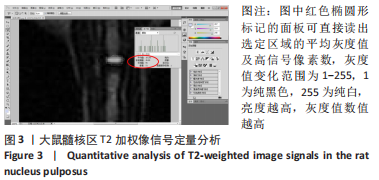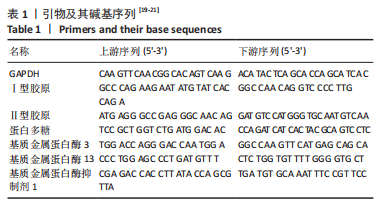[1] PFIRRMANN CWA, METZDORF A, ZANETTI M, et al. Magnetic resonance classification of lumbar intervertebral disc degeneration. Spine. 2001; 26:1873-1878.
[2] WANG H, JIANG Z, PANG Z, et al. Acacetin alleviates inflammation and matrix degradation in nucleus pulposus cells and ameliorates intervertebral disc degeneration in vivo. Drug Des Dev Ther. 2020;14: 4801-4813.
[3] QIN R, DAI S, ZHANG X, et al. Danshen Attenuates Intervertebral Disc Degeneration via Antioxidation in SD Rats.Oxid Med Cell Longev. 2020; 2020:1-12.
[4] LI K, LV C. Intradiscal injection of sesamin protects from lesion-induced degeneration. Connect Tissue Res. 2019;61(6):594-603.
[5] CHE YJ, HOU JJ, GUO JB, et al. Low energy extracorporeal shock wave therapy combined with low tension traction can better reshape the microenvironment in degenerated intervertebral disc regeneration and repair. Spine J. 2021;21(1):160-177.
[6] DAI S, SHI X, QIN R, et al. Sodium Tanshinone IIA Sulfonate Ameliorates Injury-Induced Oxidative Stress and Intervertebral Disc Degeneration in Rats by Inhibiting p38 MAPK Signaling Pathway. Oxid Med Cell Longev. 2021;2021:1-12.
[7] SCHMIDT H, REITMAIER S, GRAICHEN F, et al. Review of the fluid flow within intervertebral discs - How could in vitro measurements replicate in vivo? J Biomech. 2016;49(14):3133-3146.
[8] LIU ZZ, WEN HQ, ZHU YQ, et al. Short-Term Effect of Lumbar Traction on Intervertebral Discs in Patients with Low Back Pain: Correlation between the T2 Value and ODI/VAS Score. Cartilage. 2021;13(1):414-423.
[9] GUO JB, CHE YJ, HOU JJ, et al. Stable mechanical environments created by a low-tension traction device is beneficial for the regeneration and repair of degenerated intervertebral discs. Spine J. 2020;20(9):1503-1516.
[10] MO Z, ZHANG R, CHEN J, et al. Comparison Between Oblique Pulling Spinal Manipulation and Other Treatments for Lumbar Disc Herniation: A Systematic Review and Meta-Analysis. J Manip Physiol Ther. 2018; 41(9):771-779.
[11] ASIRI F, TEDLA JS, MS DA, et al. Effects of patient-specific three-dimensional lumbar traction on pain and functional disability in patients with lumbar intervertebral disc prolapse. Niger J Clin Pract. 2020;23(4):498-502.
[12] ZHANG YH, ZHAO CQ, JIANG LS, et al. Lentiviral shRNA silencing of CHOP inhibits apoptosis induced by cyclic stretch in rat annular cells and attenuates disc degeneration in the rats. Apoptosis. 2011;16(6): 594-605.
[13] KUO YW, HSU YC, CHUANG IT, et al. Spinal traction promotes molecular transportation in a simulated degenerative intervertebral disc model. Spine (Phila Pa 1976). 2014;39(9):550-556.
[14] ALIBEGOVIĆ A, BLAGUS R, MARTINEZ IZ. Safranin O without fast green is the best staining method for testing the degradation of macromolecules in a cartilage extracellular matrix for the determination of the postmortem interval. Forensic Sci Med Pat. 2019;16(2):252-258.
[15] HU S, ZHANG C, NI L, et al. Stabilization of HIF-1α alleviates osteoarthritis via enhancing mitophagy. Cell Death Dis. 2020;11(6): 481-496.
[16] ZHANG J, WANG L, ZHANG W, et al. Synchronization of calcium sulphate cement degradation and new bone formation is improved by external mechanical regulation. J Orthop Res. 2015;33(5):685-691.
[17] FAGGIOLI F, LUIGI M. Multiplex RT-PCR. Methods Mol Biol. 2022;2316: 163-179.
[18] BACHMAN J. Reverse-Transcription PCR (RT-PCR). Methods Enzymol. 2013;530:67-74.
[19] LUO Y, ZHANG L, WANG WY, et al. Alendronate retards the progression of lumbar intervertebral disc degeneration in ovariectomized rats. Bone. 2013;55(2):439-448.
[20] MADHAVAN S, ANGHELINA M, RATH-DESCHNER B, et al. Biomechanical signals exert sustained attenuation of proinflammatory gene induction in articular chondrocytes. Osteoarthritis Cartilage. 2006;14(10): 1023-1032.
[21] NAM J, RATH B, KNOBLOCH TJ, et al. Novel electrospun scaffolds for the molecular analysis of chondrocytes under dynamic compression. Tissue Eng. 2009;15:513-523.
[22] XIN J, WANG Y, ZHENG Z, et al. Treatment of Intervertebral Disc Degeneration. Orthop Surg. 2022;14(7):1271-1280.
[23] CHOW DHK, YUEN EMK, XIAO L, et al. Mechanical effects of traction on lumbar intervertebral discs: A magnetic resonance imaging study. Musculoskelet Sci Pract. 2017;29:78-83.
[24] KULIGOWSKI T, DEBIEC-BAK A, SKRZEK A. Effectiveness of Traction in Young Patients Representing Different Stages of Degenerative Disc Disease. Ortop Traumatol Rehabil. 2019;21(3):187-195.
[25] CHE YJ, GUO JB, HAO YF, et al. Regenerating and repairing degenerative intervertebral discs by regulating the micro/nano environment of degenerative bony endplates based on low-tension mechanics. BMC Musculoskelet Disord. 2022;23(1):462-474.
[26] CHANG HI, CHEN CN, HUANG KY. Mechanical Stretch-Induced NLRP3 Inflammasome Expression on Human Annulus Fibrosus Cells Modulated by Endoplasmic Reticulum Stress. Int J Mol Sci. 2022;23(14):7951-7962.
[27] TERAHATA N, ISHIHARA H, OHSHIMA H, et al. Effects of axial traction stress on solute transport and proteoglycan synthesis in the porcine intervertebral disc in vitro. Eur Spine J. 1994;3:325-330.
[28] LAI A, CHOW DHK. Effects of traction on structural properties of degenerated disc using an in vivo rat-tail model. Spine. 2010;35:1339-1345.
[29] HAN C, MA XL, WANG T, et al. Low magnitude of tensile stress represses the inflammatory response at intervertebral disc in rats. J Orthop Surg Res. 2015;10:26-33.
[30] HUTTON WC, YOON ST, ELMER WA, et al. Effect of tail suspension(or simulated weightlessness) on the lumbar intervertebral disc. Spine. 2002;27:1286-1290.
[31] CHE YJ, LI HT, LIANG T, et al. Intervertebral disc degeneration induced by long-segment in-situ immobilization: a macro, micro, and nanoscale analysis. BMC Musculoskelet Disord. 2018;19(1):308-317.
[32] LIANG T, ZHONG DY, CHE YJ, et al. Nano and micro biomechanical analyses of the nucleus pulposus after in situ immobilization in rats. J Orthop Res. 2020;37(1):232-238.
[33] CHE YJ, GUO JB, LIANG T, et al. Controlled immobilization-traction based on intervertebral stability is conducive to the regeneration or repair of the degenerative disc: an in vivo study on the rat coccygeal model. Spine J. 2019;19(5):920-930.
[34] CHE YJ, GUO JB, LIANG T, et al. Assessment of changes in the micro-nano environment of intervertebral disc degeneration based on Pfirrmann grade. Spine J. 2019;19:1242-1253.
[35] XIA W, ZHANG L L, MO J, et al. Effect of Static Compression Loads on Intervertebral Disc: An in Vivo Bent Rat Tail Model. Orthop Surg. 2018;10(2):134-143.
[36] ANNOVAZZI L, GENNA F. An engineering, multiscale constitutive model for fiber-forming collagen in tension. J Biomed Mater Res A. 2010;92(1):254-266.
[37] FRANCHI M, OTTANI V, STAGNI R, et al. Tendon and ligament fibrillar crimps give rise to left-handed helices of collagen fibrils in both planar and helical crimps. J Anat. 2010;216(3):301-309.
[38] KO JH, KANG YM, YANG JH, et al. Regulation of MMP and TIMP expression in synovial fibroblasts from knee osteoarthritis with flexion contracture using adenovirus-mediated relaxin gene therapy. Knee. 2019;26(2):317-329.
[39] NAGASE H, VISSE R, MURPHY G. Structure and function of matrix metalloproteinases and TIMPs. Cardiovasc Res. 2006;69(3):562-573.
[40] HUANG D, PENG Y, MA K, et al. Puerarin Relieved Compression-Induced Apoptosis and Mitochondrial Dysfunction in Human Nucleus Pulposus Mesenchymal Stem Cells via the PI3K/Akt Pathway. Stem Cells Int. 2020;2020:1-16.
|
